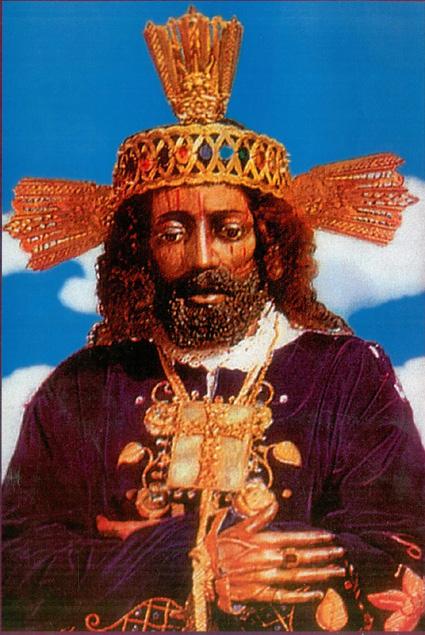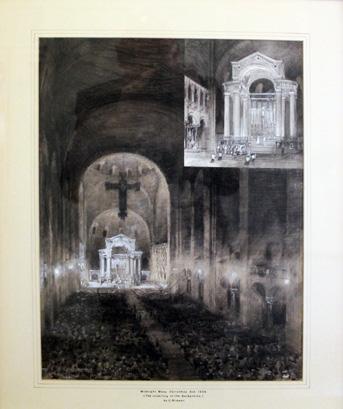
8 minute read
A Different Kind of Pilgrimage by Bishop Mark Jabalé OSB 14
Northern Region, kept as a Solemnity on 13 October. First of all people came to see the statue, then they came for the miracles worked by the Señor Cautivo. The little village of Ayabaca then took on a very great importance, and became a small town. Much more recently, in answer to a request by Daniel Turley Murphy, Bishop of Chulucanas (the diocese for Ayabaca), Pope St John Paul II, who had visited Peru and Ecuador in 1984, elevated the Parish of Ayabaca to the rank of a Sanctuary. My friend and I went there shortly after that date, on 15 October.
The most common reason Peruvians go on the pilgrimage is because they have made a promise so to do; and a promise to the Señor Cautivo, unlike most other Peruvian promises, is a promise kept. I met a young man of 19 who, during the disastrous rains of 1983, almost lost his child through dehydration. Doctors could do nothing for the baby. So, he made a promise to the Señor Cautivo that if his son got better, he would make that pilgrimage to Ayabaca for four years in succession. The boy recovered; and he was on his second pilgrimage that year. Others do it to recover from a personal illness, to mend a feud in the family, to atone for past sins, or simply out of personal devotion. A woman whose health was rather poor decided to go on the pilgrimage and she was talking to me about it. I told her that with the state of her health she really ought to think again about going on that pilgrimage; her answer was ‘Yes, of course Father, you’re quite right. Because of my health I must go on the pilgrimage’. Devotion to the Señor Cautivo is not yet very widespread in the south of Peru, but it is spreading. Pilgrimages normally begin from one of the big centres in the North, round our area. Sechura, Paita or Talara, three ports along the Pacific
© Guillermo Gonzalo Sánchez Achutegui
The statue, dressed coast, will see their pilgrims leave first, because they have furthest to walk; and, please note, strictly walking, no other transport for any part of the pilgrimage. Ninety kilomtres along, and a good day’s journey later, pilgrims will start from Piura and Sullana. Again a further day’s journey through the hot desert the road leads to Tambogrande, where we had our parish. This part of the journey is on an asphalt road, but the going is hard because there aren’t many places you can shelter from the sun, which at this season is beginning to get quite hot. Also, there aren’t many places where you can pick up water and walking in the sun is thirsty work. But at least the road is flat and the steep climbing will not come till later on. Tambogrande (grande = big or great, tambo = resting place) is the last staging post on the way to Ecuador, and most pilgrims will spend the night there.
And so you will see them, from the first week in October, walking along the main road – singly, in pairs or in groups; packs on backs, with enough food to last them the journey, although it will always be possible to buy food along the way. Most of them have a blanket wrapped around their midriffs; the only thing they will use to wrap themselves in at night to sleep on the floor. And, of course, a purple sash with a gaudy image of the Señor Cautivo, slung over the shoulder, their identification as pilgrims; this will earn them the respect and sympathy of all on the way, because the pilgrimage is a tough one and those who take part in it deserve admiration. The night before they set off, most pilgrims will have been to confession and to Mass. Confession is a rare occurrence in a Peruvian’s life, but before the Ayabaca Pilgrimage, it is traditionally a time for shriving. Most towns will lay on a special Mass for pilgrims, their families and friends, to set them on their way. By this time, those pilgrims who set out a week before, because they were carrying a cross, will be well on along the road. Yes, some do carry a cross; and when I say a cross, I mean a real one; and when I saw these in Ayabaca Church I could hardly believe anyone could have carried them all that way. This is done as a special penance because a very special favour was granted. Some pilgrims find a way to cheat, because they fit small metal wheel at the foot of the cross, to help it roll along the road.
And so, from Tambogrande to Las Lomas, the last bit of asphalted road which took us in the car a short half hour, the start proper of the pilgrimage climb; the 150 kilometres which will wind its slow four or five day journey to Ayabaca. Along the road the scenery will undergo some startling changes; but at this stage, from Tambogrande to Las Lomas, the last little town before the wilderness, and for 16 kilometres more you might well think yourself in the southern part of France between Avignon and Aix-en-Provence on a hot summer’s day; lush greens and colours, interspersed with browned and parched patches where the water has not reached. This is the Valley of San Lorenzo, an extremely efficiently irrigated area which proves that if the Peruvians got moving on irrigating the desert, the whole of that part could become a Garden of Eden. (to be continued) Bishop Mark, Emeritus of Menevia, lives in retirement at Belmont Abbey, the Benedictine House of which he is a professed member.
The Baldacchino Unveiled
Patrick Rogers

This drawing of the unveiling of the baldacchino hangs in Clergy House
On Christmas Eve 1906 the Baldacchino, the great marble canopy over the high altar in the Cathedral, was publicly revealed for the first time. It had been planned for 10 years and argued over for the last five. But neither the Architect who designed it nor the Cardinal who authorised it ever saw it. Nor would they have been very happy if they had.
When, in July 1894, J F Bentley was commissioned by Cardinal Vaughan to be the architect of Westminster Cathedral he resolved to study Romanesque and Byzantine churches before starting work on the Cathedral plans. Leaving London in November, his first destination was Milan where he was struck by the appearance of the church of Sant Ambrogio, particularly its very early baldacchino supported by four ancient purple porphyry columns. Returning from his travels in March 1895, he immediately set to work on designing the new Cathedral. By May two ground plans had been produced – the first showing a square baldacchino in the apse (where the choir now sings) and the second showing it in its present position in the sanctuary. But it was Bentley’s third and final plan, produced and approved by the Cardinal later that year, that was of most interest, for it showed the baldacchino as it is today, supported by a semi-circle of four columns on each side.
By 1901 construction of the Cathedral had reached the point at which the decoration of the sanctuary could start. Bentley was determined that the high altar and baldacchino ‘should be the crown of his work, the ark within the Holy of Holies’, as his daughter and biographer put it. He was bitterly disappointed when his design for an elaborate altar was rejected by Cardinal Vaughan in favour of a 12-ton block of unadorned Cornish granite. But he was determined not to give way on the baldacchino. As he wrote in November 1901: ‘At present I see no other way of doing the baldacchino than what I have shown, but I shall be glad of any suggestions. I know I spent a great deal of thought upon it, and I think it is the best thing about the Cathedral.’ Bentley was determined to have eight columns of yellow Verona marble 15 feet high, and was ultimately triumphant over those who argued for the more usual four columns, which would, of course, have been cheaper.
On his choice of yellow Verona, however, Bentley was opposed by the Cardinal. While in Rome after

Looking upwards from the mensa of the high altar his appointment as Archbishop of Westminster in 1892, Vaughan had been to the Basilica of St Paul Outside the Walls and was much taken by the translucency and colour of the onyx columns there. But some of these columns consist of three sections and Vaughan was determined on monoliths for the Cathedral at Westminster for ‘all the columns are monoliths and the baldacchino ought to be reared on nothing inferior’. This was despite the view of the marble merchants of London, Belgium and Paris that onyx could not be obtained in lengths of more than five to five and a half feet, whereas columns 15 feet long were needed for the baldacchino. As luck would have it, Vaughan had a friend in Marseille, Marius Cantini, who had supplied the marbles for the new Byzantine Cathedral there and owned onyx quarries in Algeria. Although it would require many months, Cantini believed he could supply onyx columns of that length.
The winter of 1901-02 passed without success, but in May Cardinal Vaughan was able to write to Lady Herbert of Lea that, for the first time, and to the surprise of the marble merchants, eight onyx columns 15 feet long had been obtained. The following month this was announced in the Westminster Cathedral Record. Bentley never saw the columns, for he had died on 2 March 1902. After his death, his assistant for almost 25 years, John Marshall, took over. But against Bentley’s express wish that the baldacchino should be produced by an English firm under the constant supervision of the Cathedral architect, Cardinal Vaughan asked Marius Cantini to submit an estimate for the whole baldacchino. This was to be made in Marseille and delivered ready for assembly, as also occurred with the font, archbishop’s throne and pulpit – all made in Rome to the dismay of Bentley. But when the eight onyx columns were










